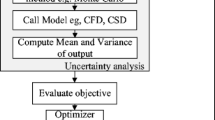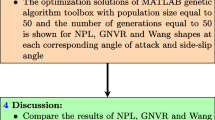Abstract
Stratospheric airship can stay at an altitude of 20 km for a long time and carry various loads to achieve long-term stable applications. Conventional stratospheric airship configuration mainly includes a low-resistance streamline hull and inflatable “X”-layout fins that realize the self-stabilization. A fast aerodynamic predictive method is needed in the optimization design of airship configuration and the flight performance analysis. In this paper, a predictive surrogate model of aerodynamic parameters is constructed for the stratospheric airship with “X” fins based on the neural network. First, a geometric shape parameterized model, and a flow field parameterized model were established, and the aerodynamic coefficients of airships with different shapes used as the training and test samples were calculated based on computational fluid dynamics (SA turbulence model). The improved Bayesian regularized neural network was used as the surrogate model, and 20 types of airships with different shapes were used to test the effectiveness of network. It showed that the correlation coefficients of Cx, Cy, Cz, CMx, CMy, CMz were 0.928 7, 0.991 7, 0.991 9, 0.958 2, 0.986 1, 0.984 2, respectively. The aerodynamic coefficient distribution contour at different angles of attack and sideslip angles is used to verify the reliability of the method. The method can provide an effective way for a rapid estimation of aerodynamic coefficients in the airship design.
Similar content being viewed by others
Abbreviations
- a for :
-
Bow length
- a cs :
-
Cylindrical section length
- c :
-
Relative thickness of airfoil
- c t :
-
Fins’ tip chord length
- C Mx, C My, C Mz :
-
Aerodynamic moment coefficients
- C p :
-
Pressure coefficient
- C x, C y, C z :
-
Aerodynamic coefficients
- d :
-
Fins’ half-span length
- R slen :
-
Slenderness ratio
- L :
-
Length of airship, m
- n 1 :
-
Bow index
- n 2 :
-
Stern index
- r C :
-
Correlation coefficient
- u, v, w :
-
Velocities, m/s
- V :
-
Volume of airship, m3
- X :
-
Real location, m
- x f :
-
Fins’ installation position
- α att :
-
Angle of attack, (◦)
- α sid :
-
Sideslip angle
- α t :
-
Total angle of attack, (◦)
- θ :
-
Meridian, (◦)
- ρ :
-
Airflow density, kg/m3
- φ :
-
Fins’ leading edge sweep angle, (◦)
References
ZHENG W, YANG Y. Airship flight mechanics and control [M]. Beijing: Science Press, 2016 (in Chinese).
LI F, YE Z Y. Aerodynamic configuration: Design of new type buoyancy-lifting airship [M]. Beijing: National Defense Industry Press, 2016 (in Chinese).
ZHAO D, LIU D X, SUN K W, et al. Research status, technical difficulties and development trend of stratospheric airship [J]. Acta Aeronautica et Astronautica Sinica, 2016, 37(1): 45–56 (in Chinese).
WANG X L, SHAN X X. Aerodynamic estimation for stratosphere airship [J]. Chinese Quarterly of Mechanics, 2006, 27(2): 295–304 (in Chinese).
LIU P, FU G, ZHU L, et al. Aerodynamic characteristics of airship Zhiyuan-1 [J]. Journal of Shanghai Jiaotong University (Science), 2013, 18(6): 679–687.
JONES S P, DELAURIER J D. Aerodynamic estimation techniques for aerostats and airships [J]. Journal of Aircraft, 1983, 20(2): 120–126.
LIU Z L. On the Calculation methods of aerodynamic force and moment in airship modeling [D]. Xiamen: Xiamen University, 2019 (in Chinese).
MENG J H, LI M N, ZHANG L C, et al. Aerodynamic performance analysis of hybrid air vehicles with large Reynolds number [J]. Unmanned Systems Technology, 2020, 3(1): 38–47 (in Chinese).
JIAO L C, YANG S Y, LIU F, et al. Seventy years beyond neural networks: Retrospect and prospect [J]. Chinese Journal of Computers, 2016, 39(8): 1697–1716 (in Chinese).
LOPEZ-GARCIA T B, CORONADO-MENDOZA A, DOMÍNGUEZ-NAVARRO J A. Artificial neural networks in microgrids: A review [J]. Engineering Applications of Artificial Intelligence, 2020, 95: 103894.
TAO J, SUN G, GUO L Q, et al. Application of a PCA-DBN-based surrogate model to robust aerodynamic design optimization [J]. Chinese Journal of Aeronautics, 2020, 33(6): 1573–1588.
CHEN H, QIAN W Q, HE L. Aerodynamic coefficient prediction of airfoils based on deep learning [J]. Acta Aerodynamica Sinica, 2018, 36(2): 294–299 (in Chinese).
WANG C, WANG G D, BAI P. Machine learning method for aerodynamic modeling based on flight simulation data [J]. Acta Aerodynamica Sinica, 2019, 37(3): 488–497 (in Chinese).
ZHANG Z C, GAO T Y, ZHANG L, et al. Aeroheating agent model based on radial basis function neural network [J]. Acta Aeronautica et Astronautica Sinica, 2021, 42(4): 524167 (in Chinese).
SPALART P, ALLMARAS S. A one-equation turbulence model for aerodynamic flows [C]//30th Aerospace Sciences Meeting and Exhibit. Reno, NV: AIAA, 1992.
FUNK P, LUTZ T, WAGNER S. Experimental investigations on hull-fin interferences of the LOTTE airship [J]. Aerospace Science and Technology, 2003, 7(8): 603–610.
POMPONI J, SCARDAPANE S, UNCINI A. Bayesian neural networks with maximum mean discrepancy regularization [J]. Neurocomputing, 2021, 453: 428–437.
HEYDECKER B G, WU J. Identification of sites for road accident remedial work by Bayesian statistical methods: An example of uncertain inference [J]. Advances in Engineering Software, 2001, 32(10/11): 859–869.
SUN Z, CHEN Y, LI X Y, et al. A Bayesian regularized artificial neural network for adaptive optics forecasting [J]. Optics Communications, 2017, 382: 519–527.
HORNIK K, STINCHCOMBE M, WHITE H. Multilayer feedforward networks are universal approximators [J]. Neural Networks, 1989, 2(5): 359–366.
CHEN M. Principles and examples of MATLAB neural network [M]. Beijing: Tsinghua University Press, 2013 (in Chinese).
LIU J P, ZHAO B T, QIAN W F, et al. Modeling and prediction of particle cutoff size of cyclone separator based on BP neural network [J]. Chemical Industry and Engineering Progress, 2021, 40(2): 671–677 (in Chinese).
Author information
Authors and Affiliations
Corresponding author
Additional information
Foundation item: the National Natural Science Foundation of China (Nos. 61733017 and 52175103), and the Natural Science Foundation of Shanghai (No. 18ZR1419000)
Rights and permissions
About this article
Cite this article
Qin, P., Wang, X. Construction on Aerodynamic Surrogate Model of Stratospheric Airship. J. Shanghai Jiaotong Univ. (Sci.) 27, 768–779 (2022). https://doi.org/10.1007/s12204-022-2494-6
Received:
Accepted:
Published:
Issue Date:
DOI: https://doi.org/10.1007/s12204-022-2494-6




